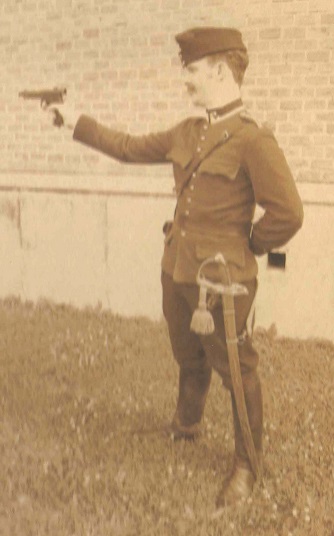(Quoting sfeile) A little off topic, but as an instructor and competition shooter, there are a few reasons that the weaver stance is fading out.
For one, the weaver takes more training to deploy consistently. Since it is a push/pull system, it is more difficult to duplicate it under stress accurately whereas the isosceles is a natural triangular push to your natural point of aim and is easier to duplicate with less training. It is also quicker to deploy from a draw, retention position, or even after being knocked onto your back as it is bringing the firearm to your natural point of aim.
Also with the above said, the weaver is less versatile. Due to the slight angle at which you turn to the target, and the opposing forces used in stabilizing, your mobility is limited. An isosceles stance maintains its point of aim turning both ways as you are squared to the target and pivot at the hips, and you still maintain the original stability throughout. So target transition, moving to cover, shooting while retreating, etc... are all done with a greater amount of control and accuracy.
When the weaver was taught, LE did not have body armor readily available and one of the thoughts behind it was to help minimize yourself as a target. Now with body armor being the norm in most departments, you want it to absorb anything you may be hit by. You actually have a better chance standing square to a perp as the side is the weakest part of the armor.
Also, as you yourself stated, eye dominance. And it is more natural for "point shooting" where you aren't even looking at your sights, because face it, when you are under duress, you are not looking for that super clear sight picture.
Bottom line however, is just as you stated in your opening:
"No question that the ideal shooting techniques are the ones where the shooter-
1. Feels most confident and comfortable
2. Results in the most effective and accurate shot placement."
And might I add, that is a beautiful Ruger you got there sir!
Not at all disagreeing with your analysis of the Weaver stance, however there are a couple of salient points to add. The Weaver uses a defensive "bladed stance" or in LE terms, the "Interview Stance", with the strong side foot to the rear and the off hand foot forward. Also known as a boxer's stance. This affords the officer to have his gun furthest away from the person being interviewed, provides for better weapon retention and is a much more stable fighting position if physical contact is made. If you are shoved while in an Isosceles stance you are going straight down on your ***. Weaver certainly has it's place in my repertoire, as does Isosceles. I use them both as the situation dictates.
I think any formal stance training is useful to a developing shooter. However, concentrating on perfecting a stance is generally counter productive to prevailing in a shooting. While we do teach a basic, modified Isosceles in the academy, It's more for conformity in having a beginning foundation for training, in the basic fundamentals of firearms and shooting skills to 130 cadets at one time, ranging in ages between 21 and 32 years of age.
It also helps with range safety, for a 130 unknown and unpredictable personal skill sets from a 130 future professionals. This is why we call it the "Basic" Academy. While we don't always teach every officer advanced skills in weapons and tactics after the academy, we do, always encourage those officers to seek out advanced training within the LE community, who do not move into a specialty area in LE, where they would automatically receive this training.
Most shootings in general, civilian personal defense or LEO defense while in the performance of their duties, takes place in extremely close distances involving very large targets. Most often than not, active gunfights involve very abrupt and dynamic movements, and are very fast and extremely violent. Actual statistics show, most officer involved shootings, find themselves in awkward positions the moment the gunfight begins.
Individual tactics are much more relevant to your survival than your stance. However, The modified Isosceles we teach in our academy, is an "reactive stance.” The Isosceles, upper body 90 degrees and square to the threat, with hands pushed forward at eye-level and the legs doing what they do in that specific situation, whether moving backwards, forwards, sideways, stationary or whatever, almost exactly mirrors, how humans naturally react when faced with a sudden close threat.
The upper body while in the Isosceles, mimics our natural startled and surprised response, as seen in most videos of officers, when responding to actual threats to life, by punching their handguns out in front of them. It is an natural and instinctive, human physical response to put a weapon between you and a perceived threat.
While the Isosceles is more of a cruder stance than a refined Weaver, combat effective accuracy, only requires hits on target. Preferably, with bullets making their impact, within three to six inches of each other, creating as much damage to multiple organs as possible. At close distances where the Modified Isosceles will most likely be deployed, a high degree of accuracy (think competition grouping) isn't generally necessary for survival. We teach our cadets, that hitting the target first, hitting it well and hitting it quickly and often, is much more critical to winning a gun fight and surviving said gunfight.
Last edited:







